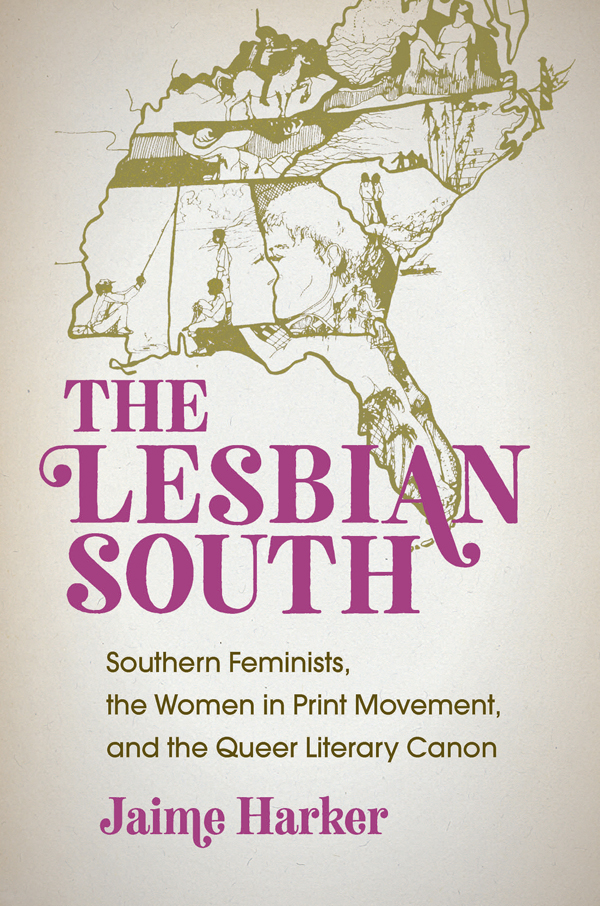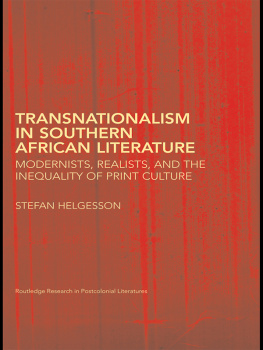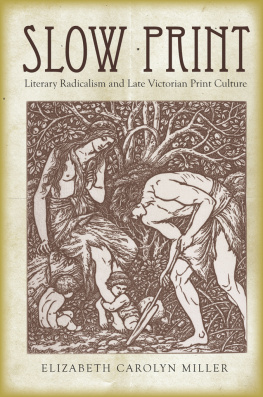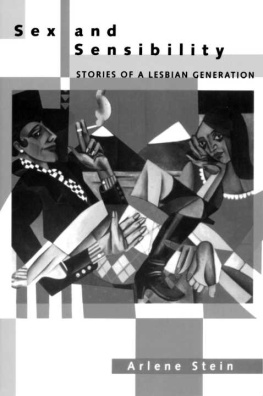Contents
Guide
Pagebreaks of the print version

The Lesbian South
The Lesbian South
Southern Feminists, the Women in Print Movement, and the Queer Literary Canon

JAIME HARKER
The University of North Carolina Press Chapel Hill
This book was published with the assistance of the Fred W. Morrison Fund of the University of North Carolina Press.
2018 The University of North Carolina Press
All rights reserved
Set in Charis and Lato by Westchester Publishing Services
Manufactured in the United States of America
The University of North Carolina Press has been a member of the Green Press Initiative since 2003.
Library of Congress Cataloging-in-Publication Data
Names: Harker, Jaime, author.
Title: The lesbian South : southern feminists, the women in print movement, and the queer literary canon / Jaime Harker.
Description: Chapel Hill : University of North Carolina Press, [2018] | Includes bibliographical references and index.
Identifiers: LCCN 2018004679| ISBN 9781469643342 (cloth : alk. paper) | ISBN 9781469643359 (pbk : alk. paper) | ISBN 9781469643366 (ebook)
Subjects: LCSH : Lesbian authorsSouthern States. | American LiteratureSouthern StatesHistory and criticism. | LesbiansSouthern StatesSocial life and customs. | Feminism and literatureSouthern States.
Classification: LCC PS 153. L 46 H 37 2018 | DDC 810.9/9206643dc23 LC record available at https://lccn.loc.gov/2018004679
Cover illustration: Untitled pictorial map of the South by Sue Sneddon, from an issue of Feminary: A Feminist Periodical for the South, Emphasizing the Lesbian Vision . Courtesy of Sue Sneddon.
For Dixie Grimes,
my lesbian feminist hero
Contents
The Lesbian South
Introduction
Southern, Feminist, Queer: The Archive of Southern Lesbian Feminism
The genesis for The Lesbian South came in 2009, when I was reading a book of essays by Jane Rule. Rule explained why she moved from mainstream presses to feminist presses: They have a growing network of bookstores all over North America, they often sell large numbers of books through direct mail order, and their customers are people for whom books are important sources of nourishment.
Naiad books were a ubiquitous presence in gay bookstores when I came out. I still own the movie tie-in edition of Jane Rules Desert of the Heart a subtle novel adapted into a spectacularly trashy movie in the 1980s. I had never thought about Naiad Press in any sustained way, other than with slight embarrassment, but it suddenly occurred to me: Naiad Press had been based in Tallahassee, Florida. This meant that the largest lesbian press in the United States had been located in the South. No one, as far as I could tell, had ever remarked on the presss location, however. Making sense of that fact led, circuitously, to this book.
In some sense, though, I have been preparing to write this book for decades. My parents moved to Atlanta in 1989. I wandered into Charis Books, one of the oldest feminist bookstores in the country, by accident; my parents lived close by. Just one look at the Naiad paperbacks and crystals let me know that I had hit the jackpot. Whenever I visited Atlanta from then on, I would go to Charis. I was something of a gay bookstore connoisseur, so I noticed that Charis had books I had never seen anywhere else. Southern gay culture, I was learning, was both distinctive and fascinating. That early exposure to gay southern culture was excellent preparation for my campus visit to the University of Mississippi in 2003. Oxford, Mississippi felt right to me from my very first visit; I still remember having lunch at the now-defunct Downtown Grill (whose executive chef would become my partner twelve years later), looking out at the courthouse, and suddenly realizing that was where Benjy went the wrong way around the Square (in Faulkners The Sound and the Fury ). And I was hooked. Despite my friends surprise, I was all in, ready to immerse myself in southern gay culture.
During my first semester, which was unsettling at best, I read John Howards Men Like That and discovered a vast, hidden network of queer southerners in places ranging from state rest stops to gay bars in Jackson, Mississippi. Howard queered the entire landscape of my new home, showing me gay Mississippi authors (including Hubert Creekmore from Water Valley, where I currently reside), ancient murder scandals, and a Mississippi Civil Rights leader caught red-handed in a gay bar. He gave me language to understand the strange open secret of queer acceptance in Mississippi: a tolerance for gay family members and friends that far surpassed that of the Mormon culture from which I sprang, a code of silence preventing anyone from actually calling those friends and family gay, and a total disconnect between the kind behavior of individuals and the homophobic voting patterns of the state as a whole (Mississippi, for example, passed its antigay marriage constitutional amendment in 2004 with an 88 percent majority). Howard made the point that what mattered in Mississippi was not if you were gay but if you were known . In small local communities, gay Mississippians, embedded in webs of kinship and friendship, lived quite comfortably, in a completely different pattern from the out gay neighborhoods of urban queers. National gay magazines frame queer life as a binary: out, liberated gays in urban areas in the North and West and oppressed, closeted queers in a homophobic South. But there is often a third way, one that Howard first articulated for me: They were aware but rather chose to ignore . I have lived in John Howards Mississippi ever since, and it has been as charming and welcoming as the man himself.
Naiad Press got me thinking differently about gay southern culture, however. Naiad Press marketed itself as the biggest lesbian press in the world; it was out , in the classic gay liberation sense of the word. Was this an aberration or a larger movement? That question led me to memoirs and bibliographies, used bookstores and interlibrary loans, archives and periodicals and unpublished dissertations, as I discovered a network of southern lesbian feminists who created a radical literary tradition. Southern lesbian feminist writers worked within a revolution in print culture known as the women in print (WIP) movement. Anchored in small feminist presses, feminist periodicals, and feminist bookstores, WIP distrusted mainstream publishing and felt that only an autonomous publishing system could allow women to build an authentic womens culture. Feminist reading and writing communities welcomed and nurtured lesbian writers in unprecedented ways by providing a broader base of readership and promotion.
Southern writers, editors, and publishers were key players in this movement. Adopted southerner Barbara Grier ran Naiad Press. Daughters, Inc., one of the most prestigious womens presses, was founded by Texan June Arnold and published Rita Mae Brown, Blanche McCrary Boyd, and Bertha Harris (from Florida, South Carolina, and North Carolina, respectively). Feminist collectives published numerous periodicals in the South, notably Charlottes Sinister Wisdom and Durhams Feminary . These print venues nurtured southern lesbian feminist writers including Minnie Bruce Pratt, Ann Allen Shockley, Alice Walker, Mab Segrest, and Cris South. These writers published not only in southern outlets but also in national feminist publications and presses like off our backs , Ms. magazine, and Firebrand Books; they also attended national conferences and participated in feminist retreats across the country. Even southern lesbian writers only tenuously connected to the feminist movement, like Fannie Flagg, or overtly hostile to it, like Florence King, participated in and benefitted from the publishing possibilities that emerged from WIP. The emergence of a Dorothy Allison would have been impossible without the feminist print culture that nurtured her.






